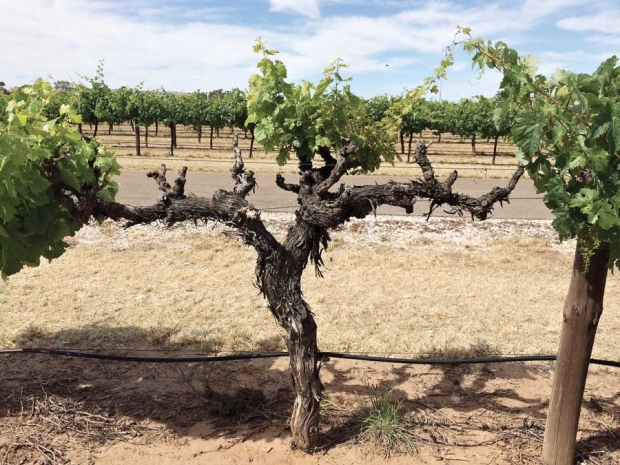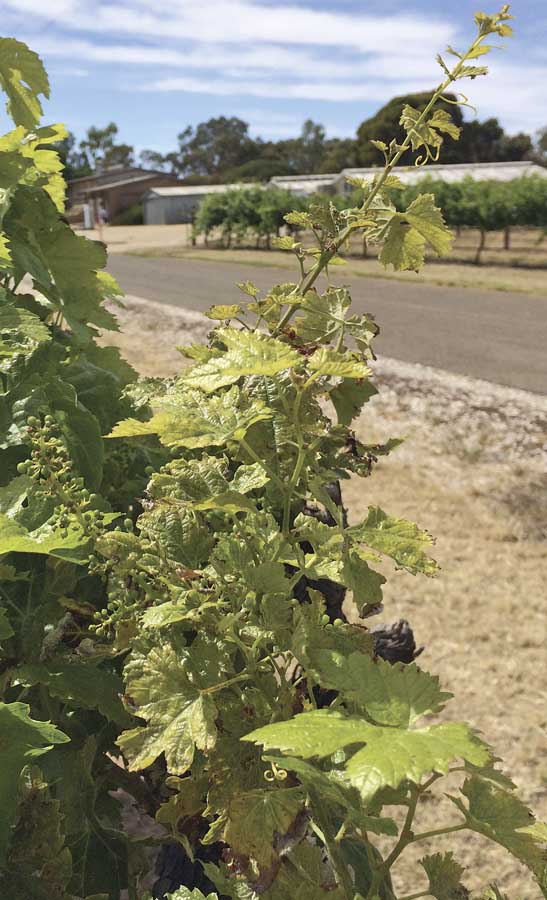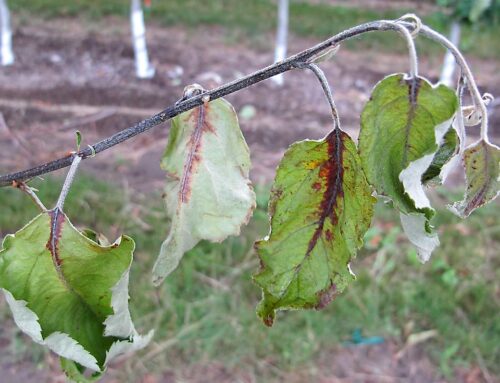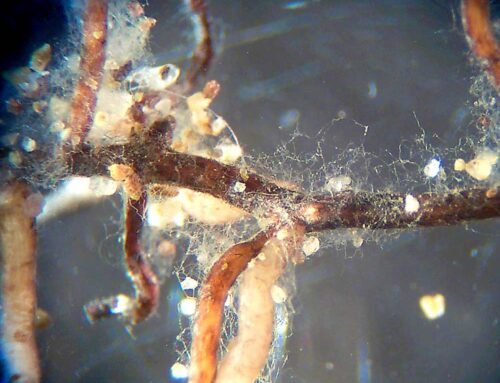
The most common symptom of the dieback-type trunk diseases (Botryosphaeria dieback, Eutypa dieback, and Phomopsis dieback) is a dead spur. It can take several months to several years for an infected spur to die, depending on the aggressiveness of the trunk pathogen. (Courtesy Kendra Baumgartner)
Trunk diseases infect a wide array of crops worldwide, including apples, cherries, blueberries and apricots, as well as grapes.
In Washington, they are a growing concern for grape growers as more acres are planted in wine grapes and as the trunks on the region’s once-nascent grapevines age.
That’s because older grapevines are more susceptible. In addition, a trunk disease can remain latent for as long as a decade, and symptoms can take one to three years to develop once it’s active.
For growers, that means the proportion of affected vines to healthy vines could reach as high as 20 percent before a problem is detected.
Knowing what pathogens are already prevalent in the region — and how to prevent them — will be crucial for growers as their industry and grapevines mature.
Washington survey
Fungal pathogens infect vines through wounds, such as those caused by pruning, and can cause wood canker symptoms years later.
The fungi infect the cordons, spurs and trunk, resulting in stunted shoots, shoot dieback and dead spurs — and cumulative yield losses.
Five wood canker diseases cause the most problems in North American vineyards: Eutypa dieback, Botryosphaeria dieback, Esca (also known as black measles), Phomopsis dieback and young vine decline complex.
Leslie Holland, a former Washington State University graduate student and current doctoral candidate at the University of California, Davis, conducted a grapevine survey to determine the prevalence of trunk diseases in Washington and what fungi are commonly associated with those diseases.
Holland gathered wood samples from symptomatic vines of multiple grape varieties and isolated diseased tissue for analysis in the summer of 2014.
She focused on seven vineyards in the Yakima Valley and Horse Heaven Hills appellations, with a total of 1,495 vines surveyed across more than 3,800 acres.
Holland found that two species of Eutypa accounted for 73 percent of the canker fungi: Eutypa laevata and Eutypa lata.
Eight other fungi caused the remaining cankers. She found symptoms in all her sample vineyards, with infection rates ranging from 3 percent to 33 percent, and the rates correlated with the age of the vines.
At a 230-acre vineyard in the Yakima Valley with vines more than 40 years old, she found a disease rate of 33 percent.
At a 2,000-acre vineyard in the Horse Heaven Hills with vines 30 years and older, she found a disease rate of 18 percent. At a 170-acre vineyard in the Horse Heaven Hills with vines 16 and 17 years old, she found a 3 percent disease rate.
Prevention potential

The foliar symptoms of Eutypa dieback appear in spring. Shoots growing from infected spurs will be stunted, with shortened internodes. The leaves are yellow and deformed, with veins that tend grow in a parallel orientation, and tattered, slightly scorched margins. (Courtesy Kendra Baumgartner)
The only means of eradicating an infection from a grapevine is by cutting out the infected wood, but healthy-looking wood can also harbor infection.
In California, researchers have identified the two most effective preventative practices:
—Delaying pruning to a time when the risk of infection is lower (rain induces spore release, and cold weather can lengthen the time a vine needs to heal from pruning or another wound).
—Double pruning, which requires two passes through the vineyard. The first pass, after harvest, prunes canes to 10 to 12 inches above the previous year’s spurs. The second pass, in mid-March or later, prunes canes to the desired spur length.
In addition, pruning wounds should be treated with a protectant before rain.
Dr. Kendra Baumgartner, a grapevine pathologist with the USDA Agricultural Research Services at the UC Davis campus, has been studying trunk diseases in grapevines.
In a 2013 survey, Baumgartner found that California growers were hesitant to use these preventative practices in newly established vineyards, presumably out of concern about potential economic losses.
She followed that survey with an economic analysis in 2014, showing that early adoption of preventive practices can significantly reduce the impacts of trunk diseases, generating financial returns close to those of a healthy vineyard.
Baumgartner and postdoc Renaud Travadon joined Jonathan Kaplan of California State University, Sacramento, in a similar study of Washington’s wine industry.
The 2015 analysis simulated production of Cabernet Sauvignon, Chardonnay, Merlot and Riesling — the four leading wine grapes accounting for 75 percent of Washington’s wine grape production.
The researchers constructed a representative bioeconomic model for wine grape production in an infected vineyard.
The model simulated production from a healthy vineyard for a 20-year lifespan and subjected it to a trunk disease.
In one case, it assumed no preventative action had been taken, and in the other, it simulated double pruning with varying degrees of success.
Generally, the results showed that the earlier double pruning is started in the vineyard and the greater the efficacy of pruning the disease from the vines, the more likely the positive overall net returns for the vineyard at the end of 20 years.
The efficacy depends on the timing of the second pruning pass, in relation to pruning-wound susceptibility.
Pruning wounds made in early winter (in California, December and January, sometimes even in February) are more susceptible to infection than wounds made later in the dormant season (March).
That’s because winter rains induce spore release and there tends to be more rain (and more spores) in early winter.
Also, cold temperatures are thought to lengthen the wound-healing process, and early winter tends to be colder.
Given the variation in disease-control efficacies in the scientific literature, there is great uncertainty about the timing of preventative practices, Baumgartner told Good Fruit Grower.
Until detailed knowledge is available on the impacts of environmental conditions on infection — specifically, those conditions that favor spore release, transport, deposition and germination on pruning wounds — and the healing process of grapevine wounds, researchers are left to make uniform assumptions about efficacy.
“Nonetheless, the more wounds protected each year, even if it is only 50 percent, the better,” she said. “Because the infections by trunk pathogens are chronic, each infected pruning wound eventually results in a dead spur and thus fewer fruit clusters on the vine. Along this line of reasoning, it makes sense to start preventing trunk diseases in young vineyards.”
The Riesling vineyard saw a positive overall net return at the end of 20 years when double pruning was implemented in years three and five. If adopted in year 10, the results were negative overall net returns.
The researchers found similar results for Cabernet Sauvignon; however, the Cabernet Sauvignon vineyard also saw positive returns when double pruning was adopted in year 10, but only at higher efficacy rates.
Merlot showed positive returns only when double pruning was implemented in years three and five and only at high efficacy rates.
However, double pruning is no guarantee for less-profitable cultivars: It never produced positive returns in the Chardonnay model, regardless of how early in the vineyard’s life it was implemented or at any level of effectiveness.
Overall, double pruning resulted in greater overall economic returns over a 20-year vineyard lifespan compared to doing nothing to combat trunk diseases, the researchers found.
The study focused only on using practices that prevent trunk diseases and did not examine methods for dealing with an already-infected vineyard, Baumgartner said.
Growers who don’t yet have a trunk disease confirmed should consider double pruning.
She said those who already have a confirmed disease problem might consider something that growers in California are employing with success: retraining or vine surgery, a form of trunk renewal.
It involves sawing off the dead cordon, or a cordon that has many dead spurs, and retraining a new one from new canes.
For vines with more than one infected cordon (or if you only have one cordon per vine), you can retrain a new vine with a trunk sucker and saw off the old vine at the base of the trunk.
Because fungi enter the vine mostly from the pruning wounds, the infection tends to localize in the canopy, which makes this option viable as long as growers don’t wait too long, Baumgartner said.
“It’s something that can be cost effective as long as the vineyard hasn’t suffered so many years of yield losses,” she said. “As long as you haven’t dug yourselves down into a deep hole already; by then, you’re better off cutting your losses and starting from scratch.” •
– by Shannon Dininny
Vine surgery unveiled
“The idea is to cut away wherever you think there might be infection. You can see the discolored wood. It’s visible. Work your way down the canopy, cutting away the rotted, darkened wood. As you go farther down the trunk, closer to the base, the wood ends up looking healthier and healthier. Just don’t go all the way down to the rootstock.
“It’s something that can be affordable, rather than replanting a whole block, which just costs tens of thousands of dollars. If you want your vineyard to last 20 to 30 years, and you end up having to replant in year 20 because your yields are so low, it’s just so expensive. It would be so much better, maybe in year 15, to start retraining so you can keep those vines going longer.”
—Dr. Kendra Baumgartner






Leave A Comment